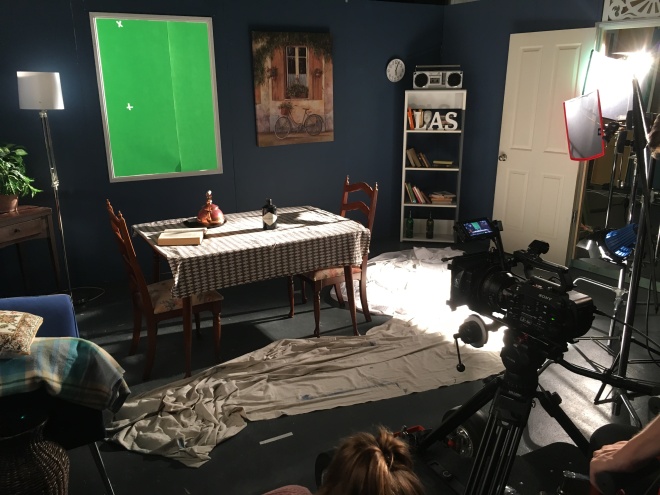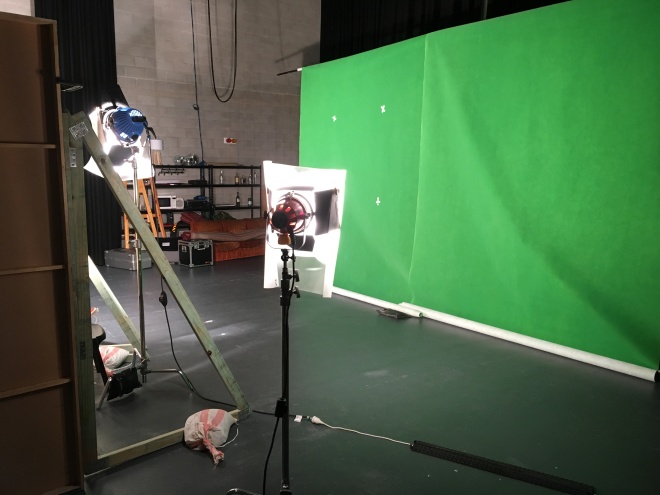We filmed a product shoot! The idea behind the project was to make a 15-second spot which either sells a particular product or sells the idea and feeling that the product show represents. However, more than an exercise in learning how to advertise, it was an exercise in lighting and making an object look as great as we possibly could. Foolishly, the object that we chose to showcase, mostly at my insistence, was a snowglobe. If you don’t understand why this was a brave and foolish decision, then you are not alone, because neither did we. Or should I say neither did I, because, as the director of photography, the problems that we encountered were almost solely in my department of camera and lighting.
I honestly didn’t think that our TVC would take us as long as it did to shoot. I realised that some commercials take quite a long time to film, but I was under the impression that most were handily shot within a day, and were often much closer to a half day project. I failed to take into account how difficult making the light dynamic and interesting on a mostly still image would be, especially given that I’m not really amazing at creating interesting and dynamic lighting setups. I’m confident with designing basic lighting setups, and can set up lights, but designing complicated lighting setups is a bit beyond me, just because I don’t understand how it all works and fits together, and the effects that each light has on the image recorded, but this is something I’m working on improving. Based on this lack of understanding, I failed to realise just how difficult lighting a spherical glass object would be, even though I did some preliminary research into the topic. Furthermore, we did a test shoot a couple days before the actual shoot, and even in the space of a few hours of messing about with lighting the snow globe for camera for the first time, I learned a lot about how the globe reflects light and colour from every angle. Doing a test shoot was a massive assistance to me in making the actual setup much easier and run smoother, but even so, the actual shoot went much longer and was much more intricate than I had thought it would be. With the help of industry professionals who were there to help us make everything look amazing, we eventually got a lighting setup that we all agreed was good enough, given our alarming lack of time and therefore need to rush a bit towards the end of the day. However, this setup that we ended up with was very different to what I originally had planned to execute for the day.Better, certainly, but also very different, further highlighting my relative inexperience at creating these complex lighting setups.
 One of the images we used as our original inspiration. Closer to the original concept than what we ended up creating.
One of the images we used as our original inspiration. Closer to the original concept than what we ended up creating.
I’m choosing to look at this as a good thing, though. Now that I’m acutely aware of where I most need to improve, I can make sure to improve it. With specific regards to lighting and designing lighting setups, there are several different ways I can see to improve my practice. There is always the option of book learning, of study and research and learning technical specifications of lights and cameras and how these interact in different situations to create different effects. Which is totally viable, and a definite starting point, but it’s not really something that really gets me enthused to try it, which is probably just a personal bias against research. The other option I see which seems a lot more fun and interesting, and is something I think I would learn a lot from regardless of the actual outcome, is to actually go out with lights and try to create all sorts of different effects and aesthetics. This is what I enjoy doing anyway, messing about with different equipment setups just to see what would happen, more or less. The potential problem of this approach is not only that transporting the lights around is difficult and time-consuming (lights in cases take up quite a lot of room and can be quite heavy), and there’s no real guarantee that you are going to learn anything particularly useful after all the effort you put in. Despite this, it’s still the way I would prefer to go because I feel like anything that I do learn or discover will stay with me a lot better if I’m physically creating it, not just reading it off a page or website.
As a group, we made the choice to have the camera pan across the snow globe, once along the top of the globe and another along the base. We also elected for the pan to move one way along the base and opposite way along the globe, which we chose to increase interest and make the globe appear more dynamic and in motion. This choice is something that has been questioned by some of the people who have seen the finalised product but is a decision that I stand behind. Not just blindly as well, we did test out options in the editing room of both the two pans going opposite ways and the two pans going opposite ways, and as a group decided that the going opposite ways were more aesthetically appealing.
 Another reference image, still close to the original Winter Wonderland theme we envisioned before reconsidering.
Another reference image, still close to the original Winter Wonderland theme we envisioned before reconsidering.
We chose the overall green and red colour scheme of the spot to represent and intensify the feeling of Christmas that the globe enjoys. The surface that the globe sits on was decided to be snow to capture a sense of wonder and magic that seems inherent with a white Christmas, but included the presents and Christmas tree with baubles and fairy lights, in the foreground and background respectively, to keep the situation relevant to Australians like us, as we don’t experience white Christmases. The fairy lights provide more interest to the background and play well with the shining and sparkling baubles on the tree as well as all being situated around the snow globe in the frame, with only black curtain behind the globe in order to highlight the ‘snow’ falling in the globe, and not obfuscate it or lose details in an overly busy frame. Finally, in post we added 2 different layers of snow falling outside of the globe, with one layer placed ‘in front’ of the globe and one ‘behind’. The idea behind this was to add depth to the frame, add more movement to the shots, and to enhance the feeling of the ‘winter wonderland’ aesthetic that we were going for. I think that this is the part of the composition that works best, and really adds a great deal to the production value and the aesthetic of the shot, and I have to commend our editor for the work he put in to learn how to create that effect and in implementing it.
 Now we’re getting closer to the final product, but not Christmas related enough for us.
Now we’re getting closer to the final product, but not Christmas related enough for us.
Honestly most of the problems we had stemmed from a lack of time, so if we could have secured a longer time period (like an additional ~2-3 hours) to complete the filming in, many of our problems could have been resolved to a higher standard. Another issue we ran into was the camera we chose to use did not have significant slow motion capability or high frame rate recording capability, so a limiting factor for us became the speed that the ‘snow’ in the globe settled, which only took a couple of seconds each time it was disturbed. Also, even during our test shoot we didn’t test shooting with the macro lens, and so only discovered on the real shoot that those shots looked awful and so were unusable in our final result. A further thing we should have done during our test shoot was practiced, refined and improved the method we used to shake up the snow in the globe, and so not ended up with several takes which were unusable because the globe was facing a different direction to previous takes, or the snow in the globe was not disturbed or shaken up enough to create interest or effect. Mostly it came down to not treating our test shoot as exactly the same as our actual shoot because all the things we didn’t take into account for the test shoot showed up as problems for the real one. The final issue that caused us any major annoyance was we were really wishing all the way through the shoot that we had brought with us a single large enough piece of poly to create the white outline effect on the glass, instead of ramshackling together what poly we had, which gave an uneven and incomplete outline of sheen around the edge of the globe. The reason we didn’t is that this was not the way I had originally planned to light the globe, and so we were just unprepared when we were told that the single large piece of poly is the way it’s done.
 Now this, this is almost as close as we came via reference image. The main differences we aimed for was looking less busy inside the globe itself and more things populating the foreground.
Now this, this is almost as close as we came via reference image. The main differences we aimed for was looking less busy inside the globe itself and more things populating the foreground.
Overall, this project is something that I am quite proud of and impressed with, because I think that we did a good job with what we chose to do, despite coming into the project without really knowing what we were getting into. The final product that we ended up with is definitely not perfect, but what we ended up releasing is something that I am definitely pretty happy with, particularly the framing, lighting and camerawork, the part I did. More than just ending up with a final product to show off, the whole experience was a very informative and I feel I learned a lot from it, particularly about lighting, but also about beauty shots in general. I’m glad that I took on this project and chose to highlight a difficult object to light because I think that is why I learned all that I did from the exercise. If it had been really easy and I could have done it all perfectly with no help, what would the point of the exercise have been? If this is something that interests you at all, I encourage you to give it a go and see what you learn through the process. I promise that it’s well worth the effort!



